A Guide to the Most Beautiful Clematis Varieties to Grow in Your Garden
Published: October 26, 2025 at 9:08:01 PM UTC
Often called the "Queen of Climbers," clematis vines offer some of the most spectacular blooms in the garden world. These versatile climbing plants can transform ordinary fences, arbors, and trellises into breathtaking vertical displays of color.
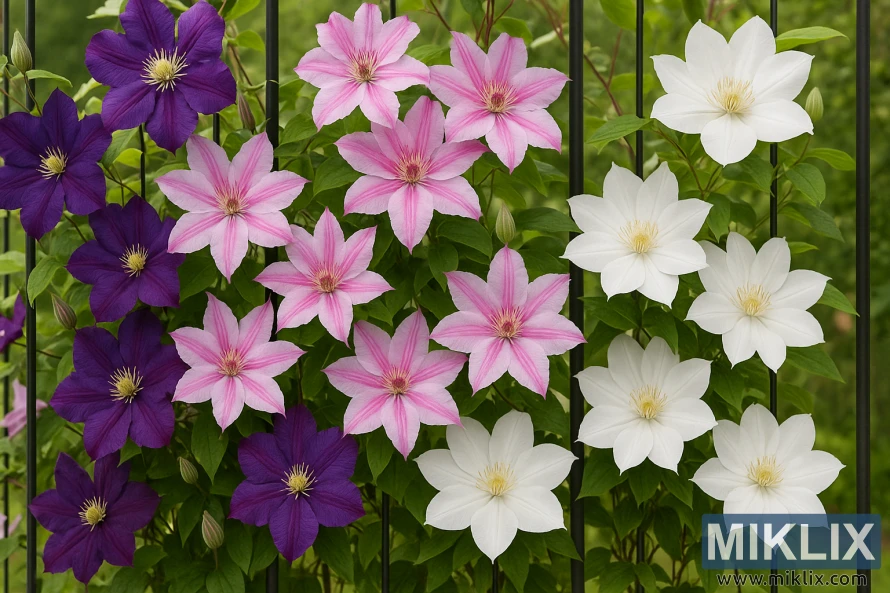
With flowers ranging from delicate bells to dinner-plate sized blooms in nearly every color imaginable, clematis deserves a place in every garden. This guide will introduce you to some of the most beautiful clematis varieties and provide essential tips for growing these magnificent vines successfully.
Why Clematis Deserves a Place in Your Garden
Clematis offers unmatched versatility in the garden. These magnificent vines can climb 6-12 feet or more, creating vertical interest where space is limited. Their spectacular flowers range from tiny bell-shaped blooms to massive 8-inch wide "dinner plates" in colors spanning crisp whites, soft pinks, vibrant reds, rich purples, and even yellow. Some varieties bloom in spring, others in summer, and some flower repeatedly from spring through fall.
Beyond their beauty, clematis are remarkably adaptable. They can be trained to climb trellises, arbors, and fences, allowed to scramble through shrubs and trees, or even grown as ground covers. With proper selection, you can enjoy clematis blooms from early spring through late fall, making them one of the most rewarding plants for any garden.
Clematis 'Jackmanii' - The Classic Purple Beauty
Introduced in 1858, 'Jackmanii' remains one of the most popular clematis varieties worldwide, and for good reason. This stunning vine produces masses of velvety, deep purple flowers with creamy yellow stamens that create a striking contrast. Each bloom measures 4-6 inches across, creating a spectacular display when the vine is in full flower.
Growing Information
- Bloom Time: Summer to early fall (June-September)
- Flower Size: 4-6 inches
- Height: 8-12 feet
- Hardiness: Zones 4-8
- Pruning Group: 3 (Hard prune in late winter)
- Sun Exposure: Full sun to partial shade
What makes 'Jackmanii' special is its reliability and vigor. Even novice gardeners can succeed with this forgiving variety. It blooms on new growth, so even if winter damage occurs, the vine will recover quickly and still produce abundant flowers. Its rich purple color pairs beautifully with roses, especially yellow varieties that provide complementary color contrast.
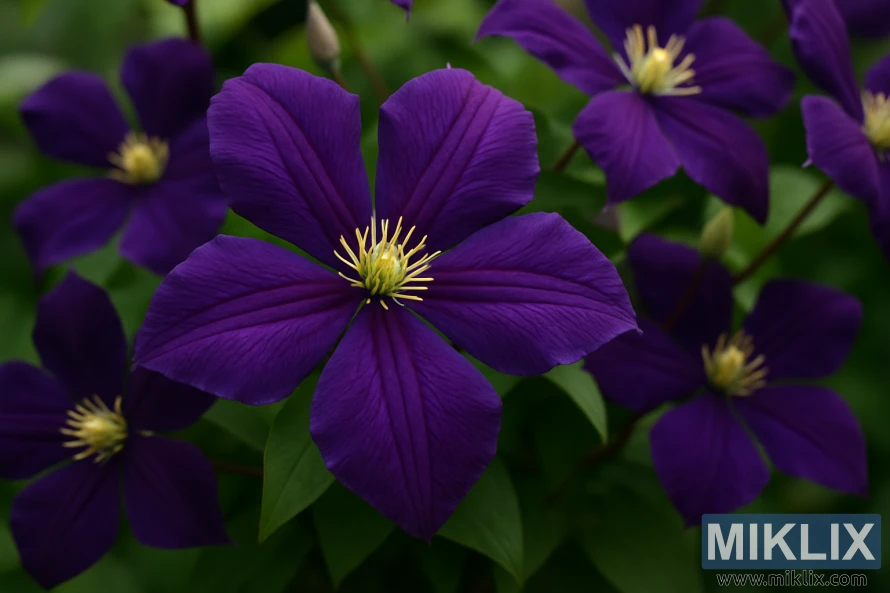
Clematis 'Nelly Moser' - The Striped Beauty
'Nelly Moser' is instantly recognizable for its distinctive pale pink flowers with bright carmine-pink bars running down the center of each petal. This bicolor effect creates a star-like pattern that catches the eye from a distance. The large 6-8 inch flowers appear in late spring and often again in early fall.
Growing Information
- Bloom Time: Late spring and early fall (May-June, September)
- Flower Size: 6-8 inches
- Height: 6-8 feet
- Hardiness: Zones 4-8
- Pruning Group: 2 (Light prune in spring)
- Sun Exposure: Partial shade preferred (morning sun ideal)
'Nelly Moser' performs best in partial shade, as strong sunlight can fade its distinctive striping. This makes it perfect for east-facing walls or fences that receive morning sun but afternoon shade. The flowers are so large and showy that they create a dramatic focal point in the garden, especially when trained on a trellis against a dark background that highlights their unique coloration.
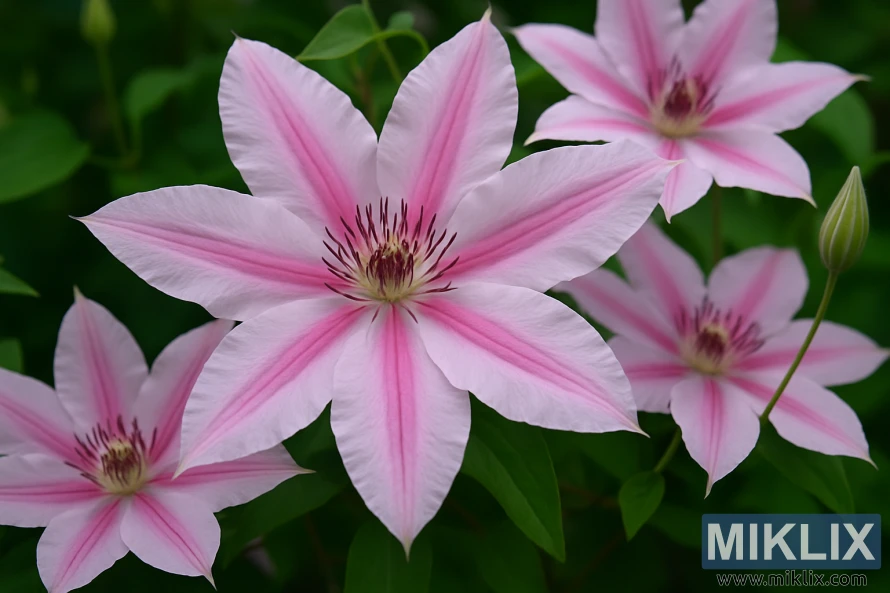
Clematis 'Henryi' - The Pristine White Beauty
'Henryi' produces some of the most impressive white flowers in the clematis world. The pristine, creamy white blooms can reach 6-8 inches across and feature contrasting chocolate-purple anthers that create a stunning focal point. The petals have a slightly ruffled texture that adds to their elegant appearance.
Growing Information
- Bloom Time: Late spring to early summer, often repeating in fall
- Flower Size: 6-8 inches
- Height: 8-12 feet
- Hardiness: Zones 4-9
- Pruning Group: 2 (Light prune in spring)
- Sun Exposure: Full sun to partial shade
'Henryi' is a versatile clematis that can brighten shady corners or add elegant contrast to colorful garden beds. Its white flowers seem to glow in evening light, making it perfect for moon gardens or areas viewed at dusk. This variety is also excellent for cutting, as the large blooms make spectacular additions to floral arrangements.
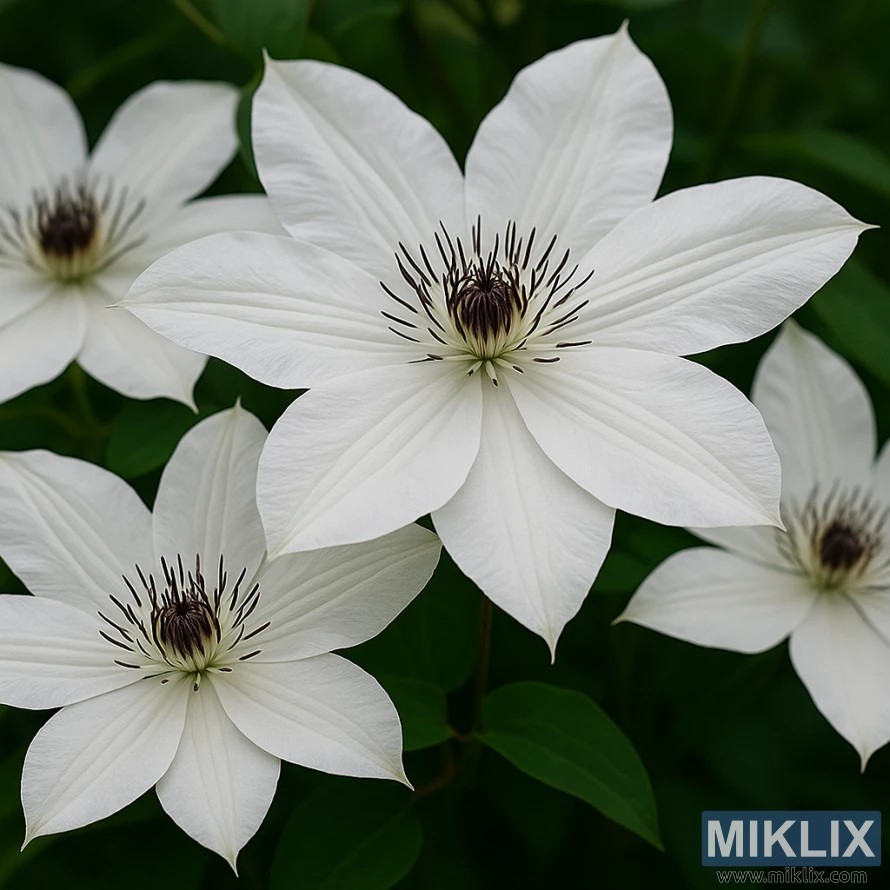
Clematis 'Ville de Lyon' - The Vibrant Red Beauty
'Ville de Lyon' offers some of the most vibrant red flowers in the clematis world. The blooms open as a rich carmine-red and mature to a slightly softer cherry-red, creating a multi-toned effect when the vine is in full flower. Each 5-6 inch bloom features golden-yellow stamens that pop against the red background.
Growing Information
- Bloom Time: Summer to early fall (June-September)
- Flower Size: 5-6 inches
- Height: 8-10 feet
- Hardiness: Zones 4-9
- Pruning Group: 3 (Hard prune in late winter)
- Sun Exposure: Full sun to partial shade
'Ville de Lyon' is a reliable performer that blooms abundantly on new growth each year. Its vibrant color makes it perfect for creating bold garden statements, especially when paired with silver-leaved plants or white flowers that enhance its rich hue. This variety is also excellent for container growing, as it remains relatively compact while still producing masses of flowers.
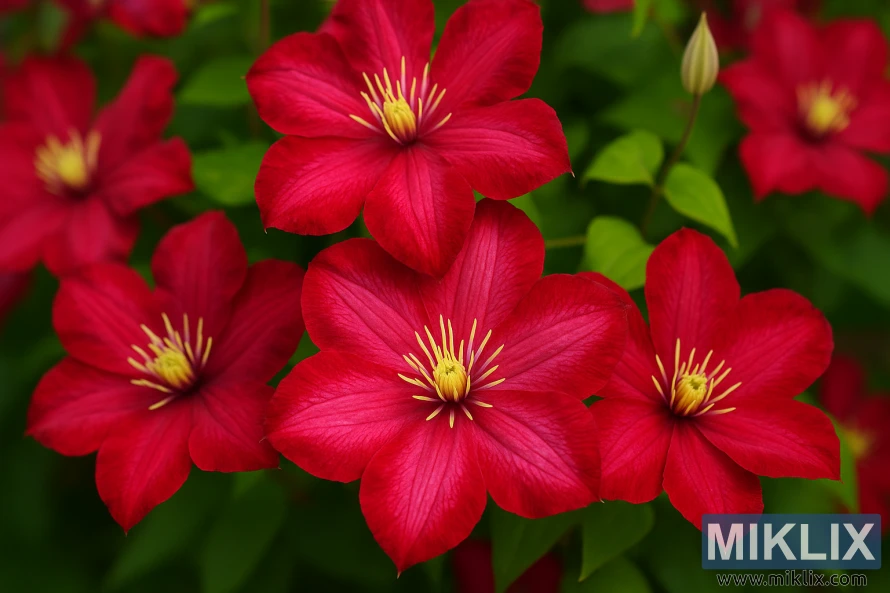
Clematis 'Duchess of Edinburgh' - The Double White Beauty
'Duchess of Edinburgh' stands out for its fully double flowers that resemble small white roses. Each 4-6 inch bloom contains multiple layers of pristine white petals, creating a lush, romantic appearance. As the flowers age, they may develop a slight greenish tinge that adds subtle dimension.
Growing Information
- Bloom Time: Late spring to early summer, sometimes repeating
- Flower Size: 4-6 inches
- Height: 6-8 feet
- Hardiness: Zones 4-8
- Pruning Group: 2 (Light prune in spring)
- Sun Exposure: Full sun to partial shade
The 'Duchess of Edinburgh' creates a refined, elegant display that works beautifully in formal gardens or cottage-style plantings. Its double flowers last longer than single forms, extending the display period. This variety can be somewhat slower to establish than others, but patience is rewarded with a spectacular floral show once the vine matures.
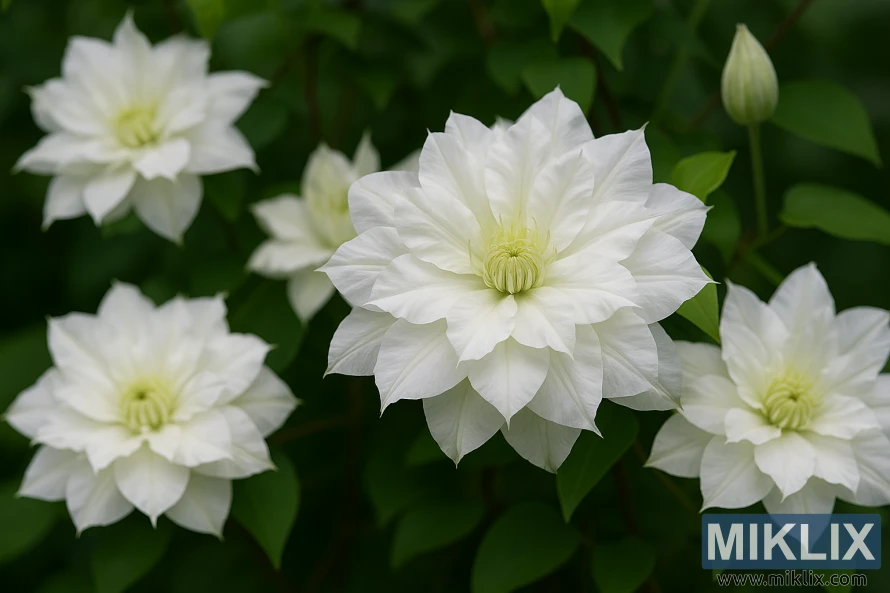
Clematis 'Princess Diana' - The Tulip-Flowered Beauty
'Princess Diana' (sometimes sold as 'Princess of Wales') offers a completely different flower form from the typical flat-faced clematis. Its deep pink to fuchsia blooms are shaped like small tulips or lanterns, with pointed petals that flare outward at the tips. This unique form creates a delicate, airy appearance that adds textural interest to the garden.
Growing Information
- Bloom Time: Mid-summer to early fall (July-September)
- Flower Size: 2-3 inches
- Height: 6-8 feet
- Hardiness: Zones 4-9
- Pruning Group: 3 (Hard prune in late winter)
- Sun Exposure: Full sun to partial shade
'Princess Diana' blooms later than many clematis varieties, providing color when other plants may be fading. Its profuse flowering habit and extended bloom time make it valuable for maintaining garden interest through late summer. The tulip-shaped flowers are also attractive to hummingbirds, adding wildlife interest to its ornamental appeal.
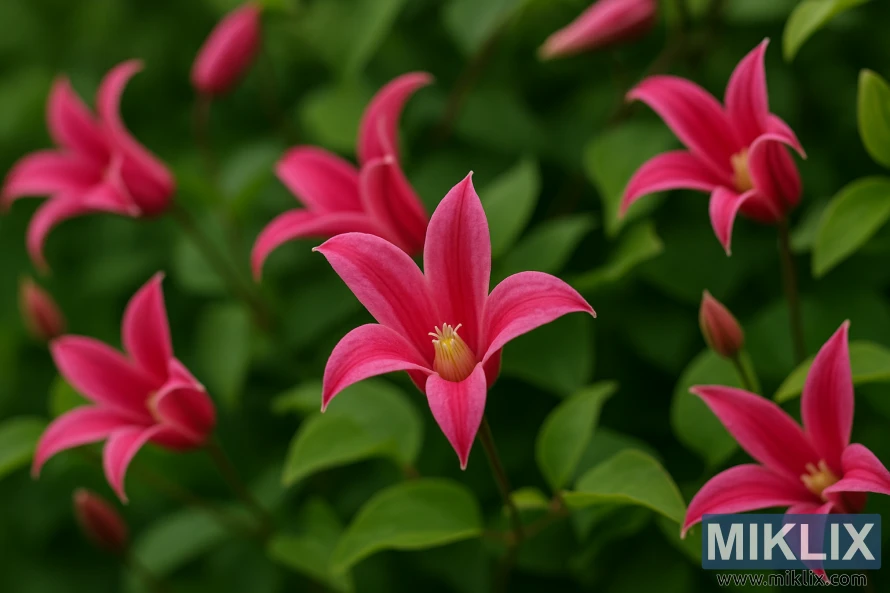
Clematis 'Blue Angel' - The Heavenly Blue Beauty
'Blue Angel' (also known as 'Blekitny Aniol') produces masses of pale lavender-blue flowers with slightly ruffled edges and creamy centers. The 4-5 inch blooms have a delicate, almost ethereal quality that creates a cloud-like effect when the vine is in full flower. The light color stands out beautifully against dark backgrounds.
Growing Information
- Bloom Time: Early to late summer (June-August)
- Flower Size: 4-5 inches
- Height: 10-12 feet
- Hardiness: Zones 4-9
- Pruning Group: 3 (Hard prune in late winter)
- Sun Exposure: Full sun to partial shade (afternoon shade in hot climates)
'Blue Angel' is one of the most prolific flowering clematis varieties, often producing hundreds of blooms in a single season. Its vigorous growth habit makes it ideal for covering large structures quickly. The pale blue color combines beautifully with roses, especially yellow or apricot varieties that provide color contrast.
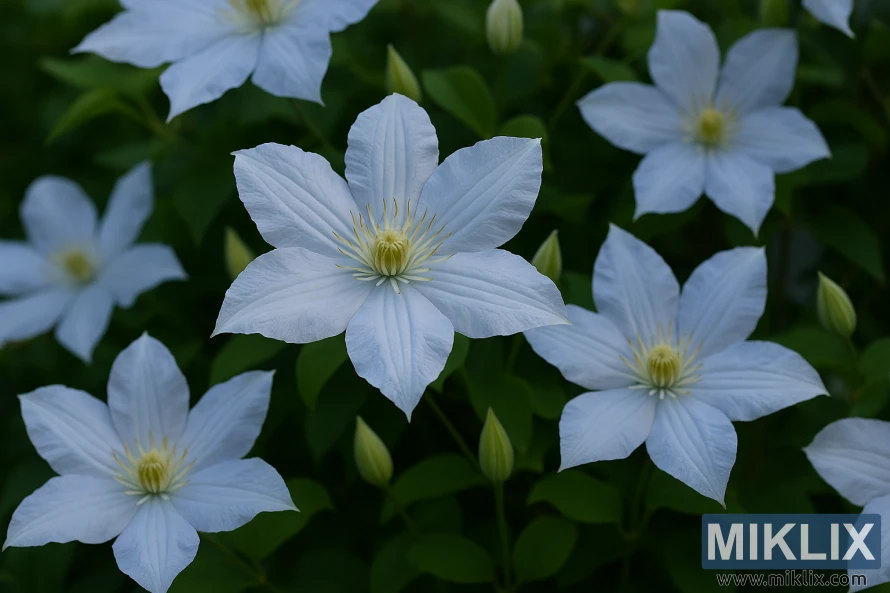
Clematis 'Niobe' - The Deep Ruby Beauty
'Niobe' features rich, velvety ruby-red flowers that create a dramatic garden focal point. Each 6-inch bloom has a slightly rounded form with overlapping petals and contrasting creamy-yellow stamens that pop against the deep red background. The intensity of color is unmatched among red clematis varieties.
Growing Information
- Bloom Time: Late spring to early summer, often repeating
- Flower Size: 5-6 inches
- Height: 6-8 feet
- Hardiness: Zones 4-9
- Pruning Group: 3 (Hard prune in late winter)
- Sun Exposure: Full sun to partial shade
'Niobe' maintains its rich color even in hot weather, when many red flowers tend to fade. It's a relatively compact variety, making it suitable for container growing or smaller garden spaces. The deep color creates a luxurious, sophisticated look that pairs beautifully with silver-leaved plants or white flowers for maximum contrast.
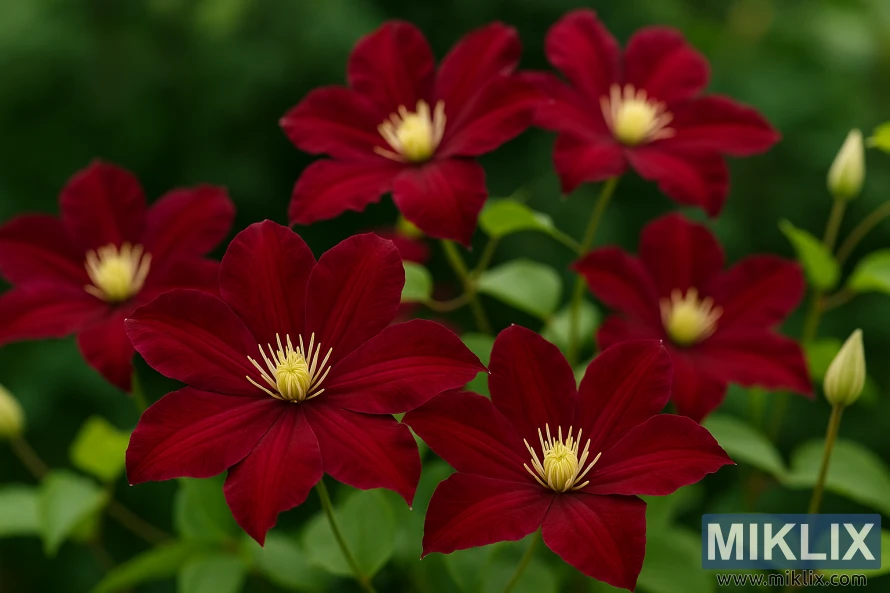
Essential Growing Tips for Beautiful Clematis
Planting for Success
Clematis have a simple but important requirement: "head in the sun, feet in the shade." This means the vines need sunshine to flower abundantly, but the root zone should be cool and moist. Achieve this by planting low-growing perennials or placing flat stones around the base of the plant to shade the roots.
When to Plant
- Spring (after last frost) or early fall are ideal planting times
- Container-grown clematis can be planted anytime during the growing season
- Avoid planting during extreme heat or drought conditions
How to Plant
- Dig a generous hole, at least 18 inches deep and wide
- Mix compost into the backfill soil
- Plant clematis 2-3 inches deeper than it was in its nursery pot
- Water thoroughly after planting and mulch the base
Understanding Pruning Groups
Proper pruning is essential for abundant flowering, but different clematis varieties have different pruning requirements. Clematis are divided into three pruning groups based on when they flower and on which growth (old or new).
Group 1
Bloom in early spring on old wood. Prune lightly after flowering, removing only dead or weak stems.
Examples: C. montana, C. alpina, C. macropetala
Group 2
Bloom in late spring/early summer on old wood, often with a second flush on new growth. Prune lightly in early spring, removing dead wood and trimming remaining stems back to strong buds.
Examples: 'Nelly Moser', 'Henryi', 'Duchess of Edinburgh'
Group 3
Bloom in summer and fall on new growth. Cut all stems back to 12-18 inches from the ground in late winter before new growth begins.
Examples: 'Jackmanii', 'Ville de Lyon', 'Princess Diana'
Support Structures
Clematis climb by wrapping their leaf stems (petioles) around supports, but these can only twist around thin structures. Provide appropriate support for your clematis to thrive:
- Use supports less than ¾ inch in diameter (wire, thin wooden dowels, fishing line)
- For larger structures like arbors, add chicken wire or string to give the vines something to grab
- Train young vines by gently tying them to supports until they establish
- Consider the mature height when selecting or building support structures
Common Problems and Solutions
Clematis Wilt
This fungal disease causes sudden collapse of stems and foliage. To manage:
- Cut affected stems back to healthy tissue
- Ensure good air circulation
- Plant wilt-resistant varieties (Group 3 types are less susceptible)
- The plant will usually recover, even if cut to the ground
Pests
Clematis are relatively pest-free, but watch for:
- Slugs and snails on young growth (use organic baits or barriers)
- Aphids (spray with insecticidal soap or strong water stream)
- Earwigs (trap in rolled newspaper or upturned pots filled with straw)
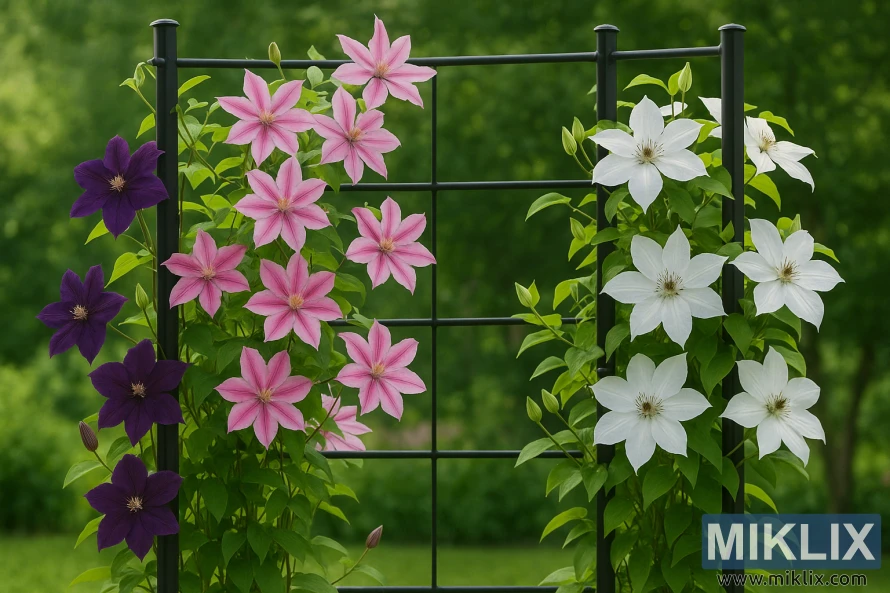
Design Ideas for Beautiful Clematis Varieties
Clematis on Structures
Clematis can transform ordinary garden structures into spectacular focal points:
- Arbors and Pergolas: Plant clematis at the base of each post for a flower-covered walkway. Combine early and late-blooming varieties for extended interest.
- Trellises: Use fan-shaped or grid trellises against walls or fences to create vertical flower displays. Paint trellises dark colors to make flower colors pop.
- Obelisks: Place clematis-covered obelisks within perennial borders to add height and vertical interest among lower-growing plants.
Clematis in Containers
Many clematis varieties grow beautifully in containers, bringing their vertical beauty to patios and small spaces:
- Choose large containers (at least 18 inches deep and wide) with good drainage
- Use compact varieties like 'Piilu', 'Josephine', or 'Ville de Lyon'
- Provide a trellis, obelisk, or decorative support within the container
- Consider planting shallow-rooted annuals around the base to shade roots
- Water consistently, as containers dry out faster than garden soil
Companion Planting
Clematis pairs beautifully with other garden plants to create stunning combinations:
With Roses
The classic pairing! Clematis and roses bloom together and share similar growing requirements:
- 'Jackmanii' with yellow roses
- 'Nelly Moser' with pink roses
- 'Henryi' with red roses
With Shrubs
Let clematis scramble through shrubs for a natural, layered look:
- White clematis through dark evergreens
- Purple clematis through yellow-flowering forsythia
- Pink clematis through blue hydrangeas
With Perennials
Plant clematis behind perennial borders for vertical backdrop:
- Blue clematis with orange daylilies
- Red clematis with white phlox
- Purple clematis with yellow coreopsis
Seasonal Interest Combinations
Create year-round interest by combining clematis with plants that shine in different seasons:
- Spring: Plant Group 1 clematis like C. montana with spring bulbs and early perennials
- Summer: Combine Group 2 and 3 clematis with summer-flowering perennials and annuals
- Fall: Late-blooming Group 3 clematis with autumn-colored foliage plants
- Winter: Appreciate the silver seed heads of clematis against evergreen backdrops
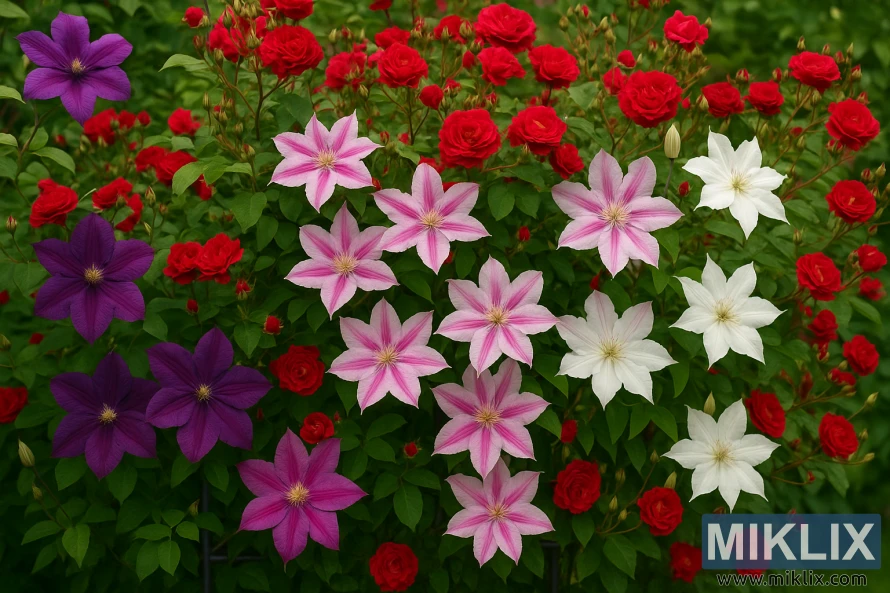
Conclusion: Growing Your Clematis Collection
The world of beautiful clematis varieties offers endless possibilities for garden enhancement. From the classic deep purple of 'Jackmanii' to the pristine white of 'Henryi', the unique tulip shape of 'Princess Diana' to the double flowers of 'Duchess of Edinburgh', there's a clematis to suit every garden style and color scheme.
Start with one or two varieties that match your garden conditions and color preferences, then expand your collection as you gain confidence. Remember the basic principles: plant deeply, provide proper support, understand your variety's pruning needs, and follow the "head in the sun, feet in the shade" rule. With these fundamentals in place, you'll be rewarded with spectacular vertical color that transforms your garden space.
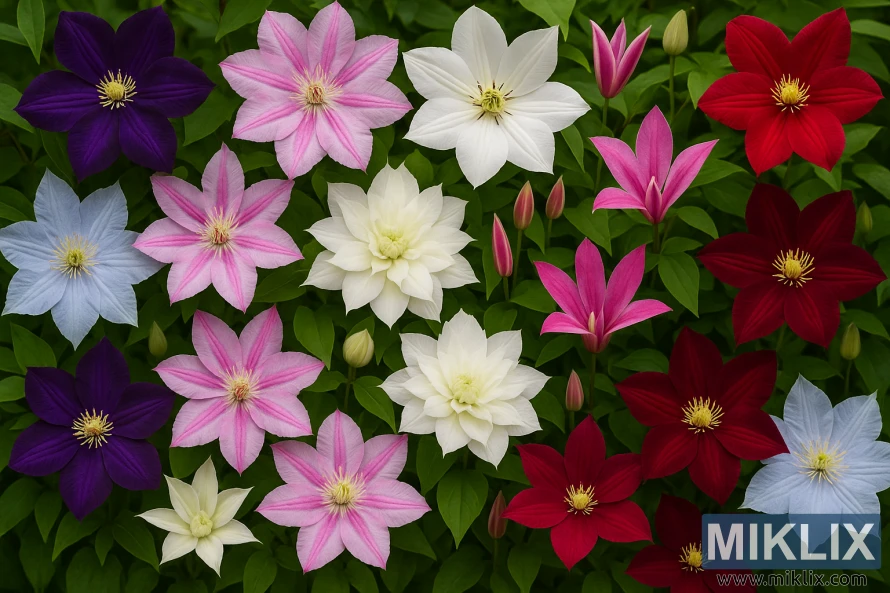
Further Reading
If you enjoyed this post, you may also like these suggestions:
- 15 Most Beautiful Flowers to Grow in Your Garden
- A Guide to the Most Beautiful Sunflower Varieties to Grow in Your Garden
- A Guide to the Most Beautiful Varieties of Bleeding Heart to Grow in Your Garden
